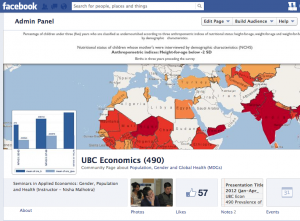
This 4th year undergraduate course, in the Economics Department, is required for all graduating students majoring in Economics. Most students come into the course excited about applying their skills learned from four years of undergraduate work to a real issue, through forming a research question and answering it by analyzing data. From the beginning, interactions between the professor and other classmates are encouraged. Peer discussions, which often generate positive externalities, can lead to a greater understanding of the costs and benefits of various policies and behaviors (Van Den Berg, Admiraal, & Pilot, 2006).
Having a place to post comments and participate without the public eye encourage involvement from the shy student and this has also been documented earlier (Larson, B.E. & Keiper, T.A., 2002). The idea of a Facebook page came from my students in the first year undergraduate class – who after having created a Facebook group for the class invited me to join the group to help them with some practice questions.
This module helped achieve what face-to-face, three-hours a week interaction could not. I have decided to make this media a permanent feature in my course.
References:
Van Den Berg, I., Admiraal, W., & Pilot, A. (2006). Peer assessment in university teaching: evaluating seven course designs. Assessment & Evaluation in Higher Education, 31(1), 19–36. doi:10.1080/02602930500262346
Larson, B.E. & Keiper, T.A. (2002). Classroom Discussion and Threaded Electronic Discussion: Learning In Two Arenas. Contemporary Issues in Technology and Teacher Education, 2(1), 45-62. Norfolk, VA: AACE Retrieved from http://www.editlib.org/p/14452.
For the complete article and an insightful discussion please follow this link
http://tinyw.in/OVPC
Experimenting with Facebook in the College Classroom
By: Nisha Malhotra, PhD in Teaching with Technology

